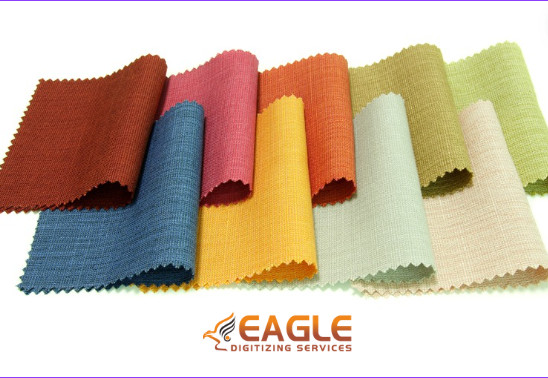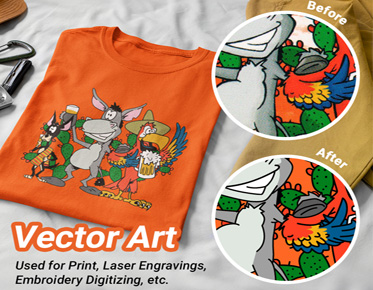From Silk to Denim: Embroidery Digitizing for Every Fabric
Embroidery digitizing has revolutionized the art of embroidery, enabling intricate designs
to be translated into digital formats for precise stitching on various fabrics.
From silk's delicate elegance to denim's rugged charm, each fabric presents
unique challenges and opportunities for digitizing. In this article, we will
explore the evolution of embroidery digitizing, the characteristics of
different fabrics, and the techniques and strategies for achieving optimal
results in digitizing embroidery designs.
Origins of Embroidery: Embroidery has a rich history dating back thousands of years, with origins spanning diverse cultures and civilizations. Initially, embroidery was painstakingly crafted by hand, requiring meticulous skill and patience to create intricate designs on fabric.
Evolution of Digitizing Techniques: The advent of technology brought about a significant shift in embroidery techniques, with the development of digitizing methods allowing designs to be converted into digital formats. Early digitizing techniques involved manual programming of embroidery machines, while advancements in computer technology led to the automation of the digitizing process.
Impact of Technology on Embroidery: Technology has played a pivotal role in shaping the modern embroidery landscape, facilitating greater precision, efficiency, and versatility in digitizing techniques. From computerized embroidery machines to sophisticated software programs, technological innovations have democratized the art of embroidery, making it more accessible to a wider audience.
Characteristics of Silk: Silk is renowned for its luxurious feel, smooth texture, and natural sheen. Derived from the cocoons of silkworms, silk fabric is prized for its softness, drape, and luster. Its delicate nature requires careful handling and specialized techniques in digitizing to preserve its integrity and enhance its beauty.
Properties of Denim: Denim is a durable, sturdy fabric characterized by its tightly woven structure and twill weave pattern. Originally used for workwear due to its resilience and strength, denim has evolved into a versatile textile popular in fashion and apparel. Its rugged texture and substantial weight present unique challenges in digitizing, necessitating specialized strategies for achieving optimal results.
Varied Textures and Weaves: Fabrics come in a diverse range of textures and weaves, each imparting unique characteristics and properties. From the smooth, glossy finish of satin to the coarse, textured surface of the canvas, understanding the intricacies of different fabrics is essential for successful digitizing. Factors such as thread count, yarn thickness, and fabric density influence the digitizing process and require careful consideration to achieve the desired outcomes.
Silk's Delicacy and Sheen: Silk's delicate fibers and natural sheen pose challenges in digitizing, requiring adjustments in stitch lengths, densities, and tensions to ensure smooth, even stitches and prevent distortion or fraying.
Denim's Thickness and Texture: Denim's thickness and coarse texture present challenges in digitizing, requiring specialized needles, threads, and techniques to achieve clean, precise stitches without causing damage to the fabric.
Other Fabric Considerations: In addition to silk and denim, other fabrics present their own unique challenges and considerations in digitizing. Factors such as stretch, shrinkage, and weight impact the digitizing process and require tailored approaches to achieve optimal results.
Adjusting Stitch Lengths and Densities: Fine-tuning stitch lengths and densities is essential for digitizing silk embroidery, ensuring the design's integrity and the finished stitches' smoothness.
Choosing Suitable Threads: Selecting suitable threads that complement silk's natural sheen and texture enhances the beauty and elegance of silk embroidery, contributing to the overall quality of the finished product.
Minimizing Tension for Silk Threads: Minimizing tension during the stitching process helps prevent distortion, fraying, or puckering of silk fabric, ensuring flawless results and preserving the integrity of the design.
Utilizing Specialized Needles and Thread: Utilizing specialized needles and thread designed for denim ensures clean, precise stitches without causing damage to the fabric, allowing for the seamless execution of intricate designs.
Adapting Designs for Denim's Coarse Texture: Adapting designs to suit denim's coarse texture and rugged aesthetic enhances the visual impact of denim embroidery, showcasing the fabric's unique characteristics and charm.
Balancing Stitch Density for Optimal Results: Balancing stitch density is crucial for achieving optimal results in denim embroidery, ensuring the integrity of the design and the durability of the stitches on this sturdy fabric.
Overview of Popular Software Programs: A variety of software programs are available for embroidery digitizing, offering a range of features and functionalities to accommodate different design needs and preferences.
Features for Customizing Designs: Software programs provide features for customizing designs, such as resizing, editing, and manipulating stitches, allowing for creative experimentation and personalization.
Importance of Compatibility with Fabric Types: Compatibility with fabric types is essential when selecting software and tools for embroidery digitizing, ensuring seamless integration and optimal performance on various fabrics.
Conducting Test Runs and Samples: Conducting test runs and samples allows for the evaluation of design compatibility and stitch quality on different fabrics, facilitating adjustments and refinements as needed.
Understanding Fabric Stretch and Shrinkage: Understanding fabric stretch and shrinkage helps prevent distortion and ensures accurate sizing and placement of embroidery designs, contributing to the overall quality and durability of the finished product.
Maintaining Needle and Thread Integrity: Maintaining needle and thread integrity through regular maintenance and replacement is essential for achieving consistent results and prolonging the life of embroidery equipment.
Experimenting with Different Fabrics: Experimenting with different fabrics allows DIY embroiderers to explore the unique characteristics and properties of each material, expanding their skills and creativity in the process.
Starting with Simple Designs: Starting with simple designs provides a practical foundation for mastering embroidery digitizing techniques and building confidence before tackling more complex projects.
Seeking Guidance from Online Communities: Seeking guidance from online communities and resources fosters a supportive learning environment where DIY embroiderers can exchange ideas, share experiences, and seek advice from fellow enthusiasts.
Embroidery digitizing offers endless possibilities for creativity and expression, transcending the boundaries of fabric diversity to unlock new dimensions of design innovation. From silk to denim and beyond, each fabric presents a canvas for exploration and experimentation in embroidery digitizing. By understanding the unique characteristics of different fabrics and employing specialized techniques and strategies, embroiderers can achieve exceptional results that elevate their craft to new heights of excellence.
If you're seeking professional embroidery digitizing services to bring your creative vision to life, consider partnering
with Eagle
Digitizing. With their expertise, dedication, and commitment to
quality, they can transform your embroidery projects into works of art that
captivate and inspire. Experience the difference with Eagle Digitizing and
embark on a journey of creativity and innovation in embroidery digitizing.



